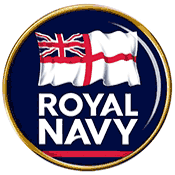Day 1 in the Royal Navy as a post-war national serviceman

Personal recollections by Fred Peach, edited by the webmaster
Some three weeks after my recruitment as a post-war national serviceman in the Royal Navy, I received a small buff coloured envelope with OHMS on the top right hand corner. (OHMS stood for On His Majesty's Service.) In it was a small octavo sized sheet of paper requiring me to report to HMS Royal Arthur at Corsham, Wilts. on or before 12 noon on 7th March 1949 to start a period of eighteen months National Service.
Then some two weeks before 7th March another brown envelope arrived at my home. This one contained a formal letter composed mainly of rubber stampings and a travel warrant which would get me from my local station at Highams Park to Corsham, Wiltshire.
So I started going through all the procedures of leaving my current employment and home.
I had been called up.
The journey to Corsham
On the appointed date I set out for my local railway station with a small case of essentials and wearing my best and only suit and shoes and with the bare essentials of clothing changes, toiletries, etc.
When I arrived at the London Terminus (which I seem to remember was Paddington) there was a group of young men standing on the appropriate platform so alike in age and behaviour to be quite obviously travelling to the same place. Conversations were slowly starting up.
The group boarded the train and we all sat in the same set of compartments, probably about thirty of us in all. Off went the train into the gloom of a dull overcast day and we ate our sandwiches en route before arriving at Corsham railway station sometime later.
It was raining in a fairly steady drizzle when we arrived in the early evening at Corsham Railway Station. It was a small country single-platform set-up with no other activity than our arrival.
We disembarked and found a Petty Officer waiting for us. He had a pushbike, wore cycle clips and just stood there while we formed a group awaiting his pleasure. Most of us had expected a sergeant-major type of person to meet us and be shouting commands ten to the dozen from the time the train stopped. Instead we crowd of recruits grew quiet as the train slowly departed and left us standing expectantly in the rain.
Eventually the Petty Officer quietly said "This all of yer then?". We nodded en masse. "Right-o then, folla me". There was no "Get fell in", no "Stand to attention", no "Keep quiet!" - nothing but that quiet "Right-o then, folla me". We dawdled after him as he pushed his bike in a slow and leisurely manner down the country road in the direction of HMS Royal Arthur.
Arrival at Corsham
On arrival we were shown to a barrack block where we each chose one of the two-tiered bunks. We then waited again. We seemed to spend most of our time waiting.
HM Barracks Ashore
Barracks Ashore consist of various sections: Living Quarters, NAAFI, Parade Ground, Wardroom Building, Food Halls, Hospital facilities, Regulating and Security Division, etc. All are present somewhere according to the layout of the establishment. A plan is always displayed for visitors.
Both Corsham and Cookham were HM Barracks Ashore.
The introductory talk
Eventually into the barrack came a short rotund Chief Petty Officer (CPO) who introduced himself.
He told us that we were at the Royal Navy's place of first entry for recruits, be they National Service or Regular, that everyone who joined the Royal Navy came through the portals of HMS Royal Arthur and stayed there for at least four weeks and that after the four weeks we would go our separate ways to undergo in-depth training in the work that we would do for the remainder of our service.
Our ration books were surrendered and we were told that fresh ones would be issued on demobilisation.
He also briefly told us what would be happening during the next four weeks - more of which is on later pages - but that now we were going to be shown where the NAAFI was and then eat.
The NAAFI
NAAFI stands for Navy, Army and Air Force Institutes. Strictly speaking it is an organisation run by the British Government but it is used colloquially as the on-site place of recreation where servicemen can buy drinks etc. or make purchases in its supermarket.
The first evening
We marched - for the first time, and not too well - to the food hall where we were given a hearty meal of surprisingly good quality.
After the meal, we wandered to the NAAFI where we spent an hour or so drinking tea, fizzy drinks or weak beer. We all then moved back to the barracks, undressed for bed (donning pyjamas probably for one of the last times) before climbing between two rough blankets and drifting off to sleep.
Our first day in the Royal Navy was over.
| sources | webmaster | contact |
Text and images are copyright
If you can add anything to this page or provide a photo, please contact me.



